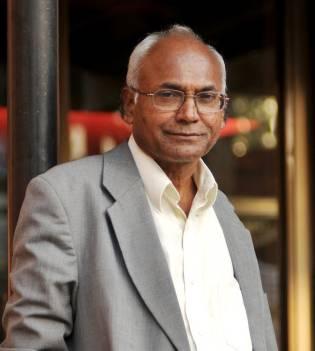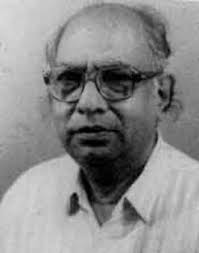Kancha Ilaiah
The Dalit-Bahujan theory or Ambedkarism cannot negotiate with funny theories of sociologists like Ashis Nandy. The best way to counter them is to write a better theory.
 Utsa Patnaik, a noted economist said in a small note that she circulated “Ashis Nandy had earlier made approving remarks on the 1988 Deorala burning to death of a young widow in the name of sati (terming it a courageous act in a piece in the Indian Express), and more recently has reportedly made a factually baseless, highly offensive comment on Dalits and corruption. Given the crudity of these positions one wonders how ‘nuanced’ and ‘ironic’ can an academic get. There is nothing here to surprise us, for Nandy has always projected a consistent intellectual position.
Utsa Patnaik, a noted economist said in a small note that she circulated “Ashis Nandy had earlier made approving remarks on the 1988 Deorala burning to death of a young widow in the name of sati (terming it a courageous act in a piece in the Indian Express), and more recently has reportedly made a factually baseless, highly offensive comment on Dalits and corruption. Given the crudity of these positions one wonders how ‘nuanced’ and ‘ironic’ can an academic get. There is nothing here to surprise us, for Nandy has always projected a consistent intellectual position.
“His writings, starting from The Intimate Enemy clearly represent an Indianised version of Romanticism, the much-analysed trend of thinking which valorises pre-capitalist traditions, local cultures and subjectivities while critically opposing the rationalism and homogenizing values of industrial capitalism.” This is a perceptive observation of Mr. Nandy’s academic romanticism. Such romaticisation of caste and culture has deeper scholastic roots.
‘High against low’
Mr. Nandy is not alone in positioning the cultural character of Indian society in a top down manner and romanticising the cultural ethos of ‘high as against low.’ This has been the cultural morale of the so-called mainstream sociological scholarship in India. The caste/class background of Indian sociologists, what they see and study in Indian society, is presented as normative and the victims of the social process are expected to affirm those theories.
This sociological methodology was invented by M.N. Srinivas who studied the Indian caste system from his own cultural standpoint and designated the process of perceived change as Sanskritisation. A systemic role was assigned to an ancient Indian language, which was already dead. Yet he turned that into a theoretical category. Its use was only in the Hindu ritual realm at that time and no Brahmin family was using that language in day-to-day life. That linguistic-cultural construction was deployed as positivist and modernist. He romanticised the so-called ‘low castes imitating the high castes,’ so much so that the whole academic discourse in India sought to be mesmerised; it was also projected as a creative utopia.
The Dalit-Bahujan life was essentially culturally inclusive as against the Brahminic exclusionism. Srinivas picked up some common food practices between Brahminic and Dalit-Bahujan (who ate vegetables alongside meat foods historically and discovered many vegetarian food items) and asserted that the lower castes were getting Sansrkitised. He discovered that Sanskritisation among the lower castes was deterministic and transformative. It was to suggest that no other forms of lower caste mobilisation were required. Though sociologists like A.R. Desai disagreed with this pseudo-transformation theory, they were ruthlessly marginalised.
Polygamy and divorce
Another noted sociologist, Andre Beteille, found Sanskritisation taking place at a systemic level on a continuous basis. He said: “Divorce, separation, polygamy etc., were common among the Dalits. The fact that they consider divorce bad is the impact of Sanskritization.” What does he mean by saying polygamy was ‘common’ among Dalits? Does he mean every second Dalit man had/has more than one wife? What about Brahmin men? Not even one in thousand was/is polygamous? Was polygamy rare among Brahmins and Kshatriyas? Where did he get his statistics about ‘Dalit polygamy’ being common and Brahmin polygamy being uncommon or rare? One hopes that the census data would include caste and polygamy relationship among all castes and religions.
His assertion that “they [Dalits] consider divorce bad” because of Sanskritisation is believed to be normative. How would he theorise the increased divorce rates among the upper castes — particularly among Brahmins? Is there no opposite linguistic-cultural concept for that? Shall we call it Palisation, as Pali was the mass language when Sanskrit was the court language? Or if we say that the process of upper castes opting for increased divorce or meat eating should be theorised as Dalitisation, what would they say? Would they not ask: what is this concept called Dalitisation?
Yet another sociologist, Dipankar Gupta, studied the Indian caste system very seriously and told the United Nations Committee on Elimination of Racial Discrimination (CERD) examining ‘Discrimination based on descent’ in 2007, that “Brahmins, Kshatriyas, Baniyas, Shudras and Dalits no more exist in India.” Is this romanticisation or mesmerisation of Indian sociology?
Corruption not a commodity
Ashis Nandy, a noted social-psychologist, spread the theoretical net of corruption to all the Scheduled Castes, Scheduled Tribes and Other Backward Classes. He discovered that the ‘most’ corrupt in Indian society came from these social groups. Has he not followed in the footsteps of MNS’ theory of “lower castes imitate the higher castes?” Does not such a statement romanticise corruption? And does not such location of ‘corruption’ among the poorest of poor endanger the whole social science discourse? Corruption is not a commodity that becomes accessible for every human being on the street. It operates, as the Sanskrit language operated among the bhoodevatas, among those who have money and power. Power among the upper castes of India is like the thread in a garland. It connects with the other quite coherently. This is not true of Dalit-Bahujan castes. A few here and there in real power (only Mayawati was in that category) structures do not and cannot connect to the most poverty ridden masses.
Several commentators, including Utsa Patnaik, pointed out that Mr. Nandy supported Sati, the theory of Mohan Bhagawat that Bharat is ‘rape free’ while ‘India is rapist,’ as it was influenced by western capitalism. It was like saying that ‘feudal rape is pure and capitalist rape is impure.’ Mr. Nandy is a Gandhian democrat. He imbibed Gandhism through Nehruvian ideology. For Gandhi, castes were necessary to maintain the balance of social system. For Nehru, corruption was the necessary greasing oil for the state engine to run. Mr. Nandy transforms this greasing oil theory into a theory of ‘social equaliser.’
‘Republican Utopia’
For his mode of Indian sociology, SC/ST/OBCs travelling ticketless in trains is equivalent to upper caste air travel with a stay in a five star hotel, without spending money from their personal account. This theory resembles the sociological theory of Andre Beteille that when Dalits eat vegetarian they get equalised with Brahmins. Mr. Nandy discovered a majestic ‘Republican Utopia’ in the Indian mode of corruption.
If “Sanskritisation” and “corruption” become part of the “Republican Utopia,” that republican utopia would match neither the ancient republican dream of Plato nor the late medieval utopian dream of Thomas More. Caste is a concrete thing at hand as slavery and class were in Europe. There is no positive sense in the notion or practice of corruption. As death cannot equalise human life, corruption cannot equalise castes. There is no way that the Dalit-Bahujan theory or Ambedkarism could negotiate with this funny theory. Neither could democratic or Marxist theory.
Equaliser theory
Since the upper castes are already corrupt, an equaliser theory is invented in the very life of Dalit-Bahujan. As the Dalit-Bahujan have no theoretical resource to counter such theories, some rushed to the police station to stop this kind of theorisation. Mr. Nandy had an intellectual answer for that recourse. “I will sit in jail and write a bigger theory.” He cites Gandhi and Nehru writing their theories in jail.
At this stage, the Dalit democratic movement cannot afford to send such theoreticians to jail and give more credence to their theories. Let it not be forgotten that there is no living Ambedkar among us to write better theory without ever going to jail. Dr. Ambedkar overtook Nehru in a recent survey with his unparalleled theory of ‘Dalit democracy’ as the equaliser. In due course, he will also overtake Gandhiji in greatness. The best way to put this kind of sociology in its place is to burn more midnight oil to write a better theory of Dalit sociological imagination — not of utopia.
(The author is Director, Centre for the Study of Social Exclusion and Inclusive Policy, Maulana Azad National Urdu University, Hyderabad).
Courtesy: The Hindu, 3/22/13









